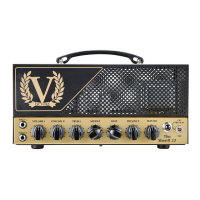4 | P a g e
TREBLE
Controls the high frequency content of your sound and is also a powerful tone shaper
when it comes to overdrive character.
MIDDLE
Controls the midrange frequencies in your sound. Run the middle control higher to help
cut through a band mix, or generally fatten and ‘widen’ your sound. Run it lower for a
lighter, less ‘in-your-face’ kind of sound.
BASS
This controls the low frequency content of your sound. Higher levels of bass can be good
at low volumes, but take care when running the amp louder – you may find you need to
reduce the bass control. As with all the EQ pots, adjust to taste!
PRESENCE
This controls a different part of the high frequency response of your amplifier than the
treble control. You might like to see it as a ‘master high end’ control that helps you tame,
or perhaps enliven your tone depending on your environment, without having to change
your EQ. As the Master Volume is post phase-splitter on the Sheriff 22, the Presence
control is positioned between the outputs of the Phase Splitter rather than in the more
conventional position in the negative feedback line. This means that it works more
effectively over the range of the MASTER volume control. It also incorporates a passive
tone circuit to tailor the high frequency content of the sound. It has a distinct effect on
how your guitar feels, so play, listen and set to taste.
MASTER
The MASTER volume control is used to set the stage or overall volume of the Sheriff 22. If
this is turned to maximum, then the 22 becomes a non-master volume amplifier where
the VOLUME I & VOLUME II controls in conjunction with the volume control on the guitar
allow for a wide range of volumes & gains to be achieved. This can be very powerful for
tone shaping.
The MASTER volume control is positioned after the phase splitter valve and after the FX
return.
OFF – PREHEAT – ON Switch
The Sheriff 22 should always be switched to PREHEAT first to allow the valve heaters to
warm up. The amplifier is now in a preheat mode with just the valve heaters and low
voltages on. This allows the valves to heat up before they get 100s of volts up them, (it’s
less of a shock).
Ensure the MASTER volume is turned down to avoid sudden deafness and after around 60
seconds, the amp can be switch to ON.

